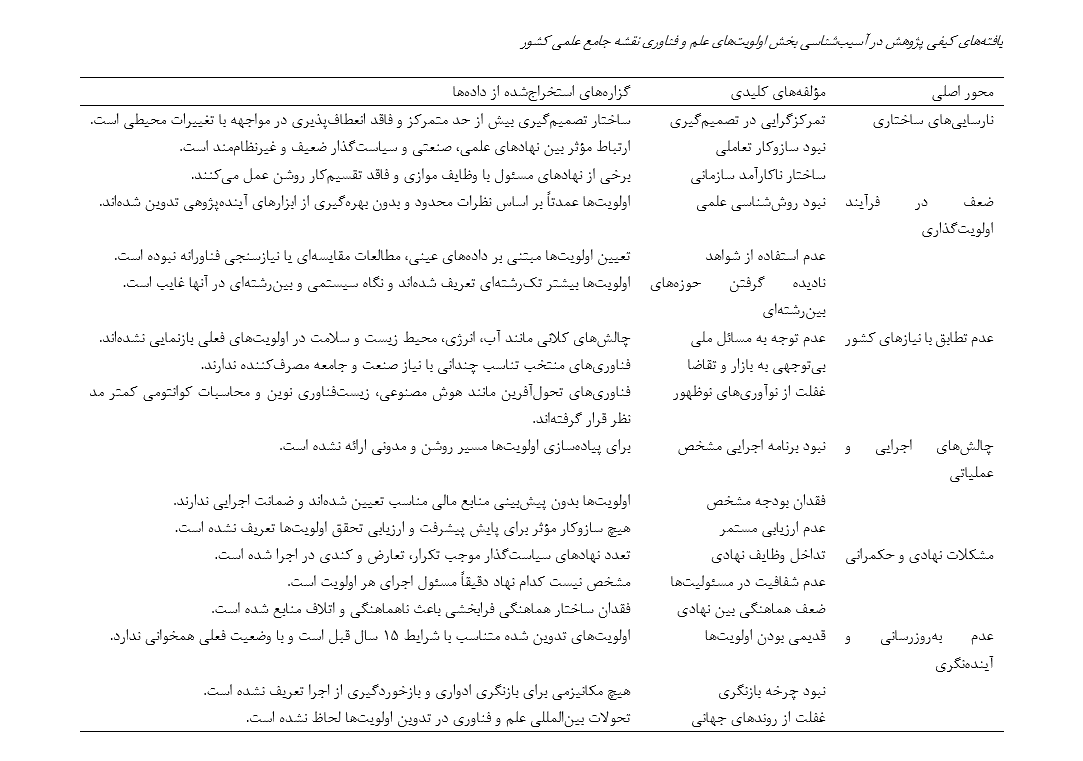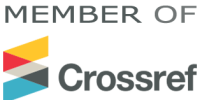Pathology of the Science and Technology Priorities Section in the National Comprehensive Scientific Map of Iran
Keywords:
National Scientific Map, science and technology priorities, science policy, qualitative analysis, institutional governanceAbstract
The aim of this study is to diagnose the weaknesses of the science and technology priorities section in Iran’s National Comprehensive Scientific Map and propose strategies for its structural and procedural improvement. This research employed a qualitative approach using thematic content analysis. Data were collected through semi-structured interviews with 18 experts, policymakers, and senior managers in the science and technology sector. Participants were selected via purposive sampling until theoretical saturation was achieved. The data were analyzed through open and axial coding, resulting in the identification of major and subcategories. The results indicated six main categories of challenges in the current priorities framework: structural deficiencies, weaknesses in the prioritization process, misalignment with national needs, implementation obstacles, institutional governance issues, and lack of updating and foresight mechanisms. Each category contained components such as centralization, lack of stakeholder involvement, missing budgetary frameworks, and insufficient attention to emerging technologies. Based on the findings, a comprehensive redesign of the science and technology priority-setting process is necessary. It is recommended that mechanisms for institutional participation, data-driven methods, and continuous evaluation systems be developed to enhance the effectiveness of science and technology policy in the country.
Downloads
References
Altundağ, C. K., & Elmas, R. (2024). Multimedia Material for Science and Technology Teaching. 100-117. https://doi.org/10.4018/979-8-3693-3041-8.ch007
Asli, B., Eghbali, M., Ghamami, N., Abbasabad, H. D., Rasuli, B., & Rezaie, F. (2019). The Necessity of Developing Knowledge Map of the World in Earth Sciences and Mines Field Studies Based on Research Activities: A Case Study of Iran. Terrae Didatica, 15, e019007. https://doi.org/10.20396/td.v15i1.8654661
Azadi, P., Mesgaran, M. B., & Mirramezani, M. (2022). Research and Development Policy. 206-222. https://doi.org/10.11126/stanford/9781503630468.003.0010
Bahadori, M., Rezayat, S. M., Tabaei, S. F., & Farhud, D. D. (2020). Convergence Science to Transform Biomedicine: A Narrative Review. Iranian Journal of Public Health. https://doi.org/10.18502/ijph.v49i2.3084
Börner, K. (2020). Maps of Science, Technology, and Education. 597-615. https://doi.org/10.1093/oxfordhb/9780190251765.013.38
Catanzaro, M. (2022). ‘I Could Not Keep Silent’: Iranian Physicist Resigns to Join Protests. Nature, 610(7932), 430-430. https://doi.org/10.1038/d41586-022-03246-x
Ehteshamnejad, E., & Pakzad, M. (2024). Preparing an Optimal Organizational Structure for the Establishment of the Supreme Council of Science, Research, and Technology Fund. Jtesm, 3(5), 53-69. https://doi.org/10.61838/kman.jtesm.3.5.4
Ghazinoory, S., & Soofi, A. S. (2017). An Introduction to the Special Issue on Science and Technology in Iran. Technological Forecasting and Social Change, 122, 104-106. https://doi.org/10.1016/j.techfore.2016.09.019
Granell, C., & Aguilar‐Moreno, E. (2018). Geospatial Influence in Science Mapping. 3473-3483. https://doi.org/10.4018/978-1-5225-2255-3.ch302
HamidiMotlagh, R., Babaee, A., Maleki, A., & Isaai, M. T. (2020). Innovation Policy, Scientific Research and Economic Performance: The Case of Iran. Development Policy Review, 38(3), 387-407. https://doi.org/10.1111/dpr.12423
Heshmati, A., & Dibaji, S. M. (2019). Science, Technology, and Innovation Status in Iran: Main Challenges. Science Technology and Society, 24(3), 545-578. https://doi.org/10.1177/0971721819873192
Khosravi, M. (2022). Research Output of Iran Over the Past Two Years: Contributions From the European Journal of Translational Myology. European Journal of Translational Myology, 32(1). https://doi.org/10.4081/ejtm.2022.10447
Mahroyan, N., Mehraein, M., & Navabakhsh, M. (2021). Systematic Review of Studies on Science and Technology in Iran. Jarac, 3(4), 80-88. https://doi.org/10.61838/kman.jarac.3.4.7
Moaveni, B. (2021). Developed Technologies and Active Startup Companies in Dealing With COVID-19 Pandemic in Iran. Journal of Control, 14(5), 97-105. https://doi.org/10.52547/joc.14.5.97
Namdarian, L. (2017). Evaluation of Science, Technology, and Innovation (STI) in Iran. Collnet Journal of Scientometrics and Information Management, 11(2), 253-271. https://doi.org/10.1080/09737766.2017.1321728
Nazerian, R. (2024). Development of Two-Stage EBM Data Envelopment Analysis Model for Evaluation of Science and Technology Parks. Jes, 20(3), 4407-4418. https://doi.org/10.52783/jes.5769
Rahimi, A., Varmazyar, R., Ghalavand, H., & Shirshahi, S. (2024). Mapping and Analyzing the Scientific Outcomes of Medical Library and Information Sciences (1990–2022). Awari, 5, 1-13. https://doi.org/10.47909/awari.714
Rezaeisadrabadi, M. (2021). Science and Technology Parks and Incubators in Iran: Review. Roshd -e- Fanavari, 17(66), 53-62. https://doi.org/10.52547/jstpi.21008.17.66.53
Safaei, F., Abhari, K., Khosroshahi, N. K., Hosseini, H., & Jafari, M. (2019). Erratum: Optimisation of Functional Sausage Formulation With Konjac and Inulin: Using D-Optimal Mixture Design. Foods and Raw Materials, 439-439. https://doi.org/10.21603/2308-4057-2019-2-439
Shirshahi, S., Azad, R. V., & Riahinia, N. (2024). Mapping the Research Structure on Crohn’s Disease in PubMed and Web of Science (2014-2023). Awari, 5, 1-10. https://doi.org/10.47909/awari.47
Shojaee-Mend, H., Mahi, M., Khajavi, A., Maleki, M., & Nabiolahi, A. (2024). The Potential Use of Digital Health in Iran: A Systematic Mapping Review. Frontiers in Health Informatics, 13, 198. https://doi.org/10.30699/fhi.v13i0.583
Soofi, A. S., & Goodarzi, M. (2017). The Development of Science and Technology in Iran. https://doi.org/10.1057/978-1-137-57257-8
Tatfi, S. A. M. (2017). Regional Innovation System Analysis Model: The Case of Iran. Lebanese Science Journal, 18(2), 264-278. https://doi.org/10.22453/lsj-018.2.264-278
Yazdi, M. (2021). The History of Mineralogy and Gemology in Iran. Earth Sciences History, 40(2), 566-580. https://doi.org/10.17704/1944-6187-40.2.566

Downloads
Published
Submitted
Revised
Accepted
Issue
Section
License
Copyright (c) 2025 Ehsan Ehteshamnejad ; Mahdi Pakzad (Author)

This work is licensed under a Creative Commons Attribution-NonCommercial 4.0 International License.










